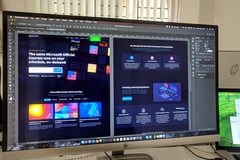Index Content
When we talk about responsive design, we are talking about adaptation. This web design technique seeks, in short, the most correct way to visualise a page on different devices, from computers to tablets and mobiles. Its importance is essential when designing any web page.
{% video_player "embed_player" overrideable=False, type='hsvideo2', hide_playlist=True, viral_sharing=False, embed_button=False, autoplay=False, hidden_controls=False, loop=False, muted=False, full_width=False, width='1920', height='1080', player_id='82860276642'', style='' %}Main points of an optimal responsive design
Resizing and positioning have become the main axes of any website, as what is sought is the adaptation to the width of each device, in general, and the correct visualisation and advantage for the user, in particular. Responsive design has thus become a web technique capable of reducing development time and increasing the flow of contents that circulate through it. However, what does a responsive design need to be optimal? Here we explain the main elements for a responsive design.
Elements for a responsive design
- Visualisation: This is one of the simplest points, as it only requires using one's own judgement and assessing the attractiveness of the web page. It is relatively easy to look at a website, just by glancing at its appearance, which is enough to assess whether the space is eye-catching, beautiful, of high quality, or if, on the contrary, it is not very attractive.
- Professional logo: This is one of the fundamental elements for responsive design, as it allows quick identification with your activity or environment. It must have characteristics adapted to simplicity, modernity, be simple, memorable, versatile and, above all, appropriate. The corporate image, in short, defines your company.
- Call to action (CTA) or key message. It is essential to have one of these elements to serve as a gateway for users. Without a clear and complete CTA is a guarantee of incomplete marketing that, ultimately, would not perform its main task successfully. Calls to action or key messages should be clear and understandable to visitors.
- Contact number: In general, it should be placed at the top of the web page, which will facilitate the process and the speed of communication. Both the telephone number and several CTAs are two of the many essential elements for your website.
- Clarity in what is offered. The website must be very well specified in the field, activity, product, etc., that is offered. In this way, if we do not establish a clear and concise description, the visitor will not be able to understand it. This is where the content comes into play, whose value will make potential customers get involved with it. It is necessary, therefore, to have informative content that is easy to read.
- Action for visitors: The website should guide visitors, so set up forms where they can leave their email address, for example, to gain access to download a free resource/content.
- Secondary actions: This is essential if visitors are not interested in the main action, so social media sharing becomes the main alternative.
- Navigation menu. Its design is complicated but very effective. Websites with good menus allow a more attractive design and ease of navigation. In this way, a good menu allows users to easily find their way.
- Social networks: The company must have a constant presence in the chosen social networks, so including their buttons on your website can be a fundamental way to generate followers.
- Meta description: This HTML tag allows you to describe the article on the web page in a summarised and sequential way. As a result, it will appear in search engine results just below the page title. This is one of the parts of the optimisation.
- Forms are a good opportunity to capture visitors' email addresses. Although many companies overlook them, this will help the email marketing strategy a lot.
- Title: Check that there is a unique title for each page, as this is a main tool that will attract new visitors. This, consequently, should be short and with a very careful design.
- Write a minimum of 500 words on each page and check that it reads properly, with paragraphs, bullets, links and keywords.
where to focus?
At this point, it is important to bear in mind that, for the content of the website to flow smoothly and circulate properly through the different devices, the main focus should be on an adjustable screen and images. In the same way, the main objective we are pursuing is to achieve a good responsive design for our website, so the fundamental question to be asked, finally, is the following: Does the content look good on any device? In turn, it is also important to know who our buyer persona is and revolve every action around it. With all the elements of responsive design mentioned and established effectively, any website can become a quality site where visitors enjoy a pleasant experience.
{{cta('7224d593-122c-408e-a33c-dce3cbe35ece')}}




